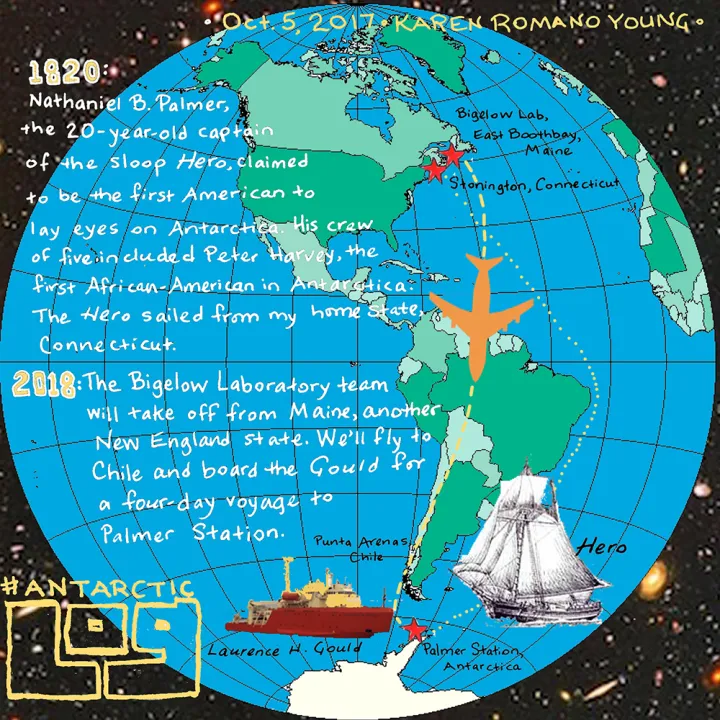Comics at Sea: An Antarctic Logbook

For five years, I've had a photograph of Palmer Station, Antarctica, tacked up over my desk. Taken from Torgensen Island, it shows the resident Adélie penguins in the foreground, pale blue water dotted with ice, and the sharp rise of Mount Williams in the background. The seemingly fragile gray, green, and gold buildings of the research station stand at the edge of the land. Looming above them is what looks at a glance like a thick layer of fog, but it's not-it's a glacier, hulking pinkish-gray in the rosy light of round-the-clock sun.
I can't wait to get there.
Usually a logbook is kept by someone on an expedition, not someone still home at her drawing table in Connecticut. But my expedition really starts with trying to get ready-mentally and physically-for a trip to Antarctica. A full battery of tests and checkups is required for working in a remote location that has enormous physical demands-and no hospital nearby. Mental preparations involve getting ready to leave home for two months, and bracing myself for long hours, tough conditions, and homesickness. Among other things, I've been shopping for long underwear, taking myself for long walks in the cold, and reading about historic and modern Antarctic explorations.
On March 29, I'll arrive at Palmer Station, one of three American research stations on the West Antarctic peninsula, the arm of land and ice that reaches its long finger toward the southernmost point of Chile.
My comics aren't what you would typically find in an expedition logbook, but they aren't completely out of the ordinary. Historically, voyages were documented by scientific illustrators and journal entries from intrepid naturalists. Their stories and images help us learn more about Antarctica as it existed hundreds of years ago and track changes to the landscape and ecosystem over time.
My first comic popped into my head the day I got a mandatory blood test in preparation for the trip. The conversation I had with the phlebotomist at the lab about the Ozone Hole got me thinking about the way Antarctica figures in the imaginations of people, and it made me realize that my trip gave me the chance to learn more about those stories, and to tell my own in ways that inform people about important issues and changes happening in a site very far removed from most people's day-to-day lives.
The scientists I will work with hail from the Bigelow Laboratory for Ocean Sciences in East Boothbay, Maine and specialize in things you cannot see-plankton. It may seem a little strange that they're bringing along a visual storyteller, since you need a microscope to see the tiny plants that form the base of the Antarctic food chain, but my #AntarcticLog comics can help those sitting in front of a computer get a better idea of the small things that we can't see and understand their importance to Antarctic creatures, big and small.
As I write this I'm well into week 35 of my #AntarcticLog, with no end in sight. Week 44 will find me aboard the Lawrence M. Gould, a U.S. research vessel plowing through the tempestuous seas between Punta Arenas, Chile, and our destination-Palmer Station.
I'll keep updating #AntarcticLog as I'm inspired by the icy landscape.
Editor's note: We will be sharing stories from Karen Romano Young's expedition here on the Ocean Portal throughout her travels. The National Museum of Natural History has tentatively planned activities with Karen that include live interactive chats with her from Antarctica. You can find support materials for schools, additional information about Antarctic topics, and a science comic contest for young artists ages 10 to 18 on her website www.antarcticlog.com.




